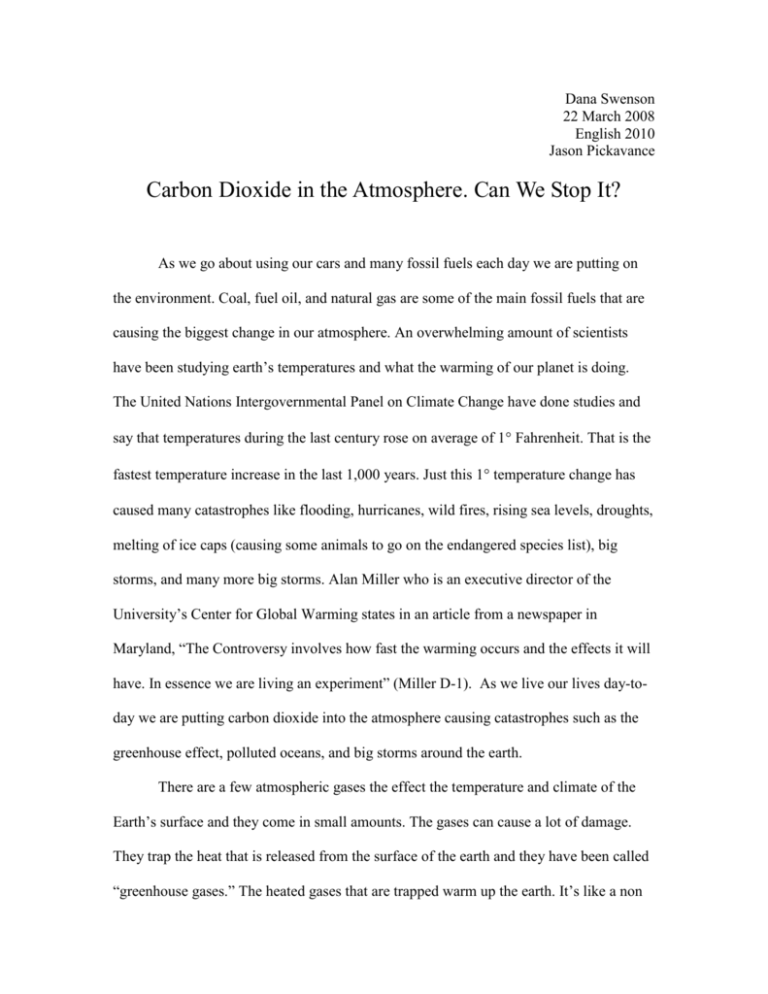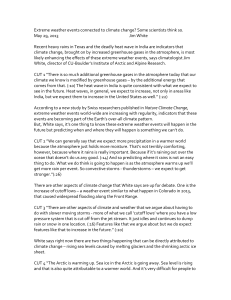Dana Swenson - WordPress.com
advertisement

Dana Swenson 22 March 2008 English 2010 Jason Pickavance Carbon Dioxide in the Atmosphere. Can We Stop It? As we go about using our cars and many fossil fuels each day we are putting on the environment. Coal, fuel oil, and natural gas are some of the main fossil fuels that are causing the biggest change in our atmosphere. An overwhelming amount of scientists have been studying earth’s temperatures and what the warming of our planet is doing. The United Nations Intergovernmental Panel on Climate Change have done studies and say that temperatures during the last century rose on average of 1 Fahrenheit. That is the fastest temperature increase in the last 1,000 years. Just this 1 temperature change has caused many catastrophes like flooding, hurricanes, wild fires, rising sea levels, droughts, melting of ice caps (causing some animals to go on the endangered species list), big storms, and many more big storms. Alan Miller who is an executive director of the University’s Center for Global Warming states in an article from a newspaper in Maryland, “The Controversy involves how fast the warming occurs and the effects it will have. In essence we are living an experiment” (Miller D-1). As we live our lives day-today we are putting carbon dioxide into the atmosphere causing catastrophes such as the greenhouse effect, polluted oceans, and big storms around the earth. There are a few atmospheric gases the effect the temperature and climate of the Earth’s surface and they come in small amounts. The gases can cause a lot of damage. They trap the heat that is released from the surface of the earth and they have been called “greenhouse gases.” The heated gases that are trapped warm up the earth. It’s like a non escaping cloud surrounding the earth so no heat can get out. “The greenhouse effect is a warming of the earth and atmosphere as a result of thermal trapping of incoming solar radiating of CO2 water vapor, methane, nitrous oxide, chlorofluorocarbons, and other gases, both natural and manmade” (replacing gasoline 10). When the gases are in the atmosphere they form what is like a greenhouse. In a greenhouse with plants, trees, or flowers it traps in the moisture so that no water can escape it can all go into the plants. While on this planet we need to really watch what we put into the air we breathe because the earth is like a greenhouse. It traps carbon dioxide in the atmosphere which heats up the earth. Burning fossil fuels is a man made activity which has trapped more carbon dioxide in the atmosphere causing global temperatures rise. There are many facts leading to the reason for some of earths catastrophes like hurricanes, flooding, big wind storms, tornados, and more that all trace back to global warming. “Astronomers believe that the young Sun was dimmer than the present-day Sun by 30 percent. Over the last 4 thousand million years, it has gradually brightened. During this increase, Venus’s surface water evaporated and entered the atmosphere,” says David Grinspoon, Denver Museum of Nature and Science, and one of Venus Express’s interdisciplinary scientists. Greenspoon also talks about some of the feed back from the heating up of our planet which has increased in the past 50 years, “Water vapor is a powerful greenhouse gas and it caused the planet to heat-up even more. This is turn caused more water to evaporate and led to a powerful positive feedback response known as the runaway greenhouse effect” (Grinspoon). This chart gives a good description explaining how the greenhouse effect works. One problem on earth that has been a problem for a long time is the pollution people put into the oceans. From oil spills to dumping gas or other toxins into the oceans or lakes these are all some of the main problems causing pollution. Hundreds of ships who transport about 90 percent of the world’s goods sail the ocean each day. These ships are full of cars, computers, toys, shoes, foods, and clothes. These consumer goods let so much pollution into the air we breath and oceans in forms of toxins causing the people to pay a high price in forms of health problems. These health problems include cancer, breathing problems, and premature death. Cruise Ships burn so much fuel per hour causing more human-generated global gases. Cruise ships let more toxins in the air than any airplane or commercial aviation. These cruise ships also pollute coastlines and oceans by dumping sewage directly into the ocean, garbage over board, or letting out dirty gray water. The ocean waters are warming up along with the air that many of Antarctica’s ice caps are starting to melt away. In September of 2004 a record of 160 miles retreated north of the northern coast of Alaska causing hundreds of polar bears who lived on these ice caps to die. They likely drowned from swimming long distances with no food and being to tired. A marine-biology professor at the University of Alaska, Richard Steiner, states, "For anyone who has wondered how global warming and reduced sea ice will affect polar bears, the answer is simple -- they die.” Because of the many catastrophes and melting of the many ice caps on earth the polar bears could soon be extinct. Hurricanes are slashing rains that cause major flooding and they bring big winds which cause homes to get destroyed. People die or are left picking up the pieces to their homes and what is left. Is global warming helping these storms and making them more dreadful? Jay Barnes of Pine knoll Shores, North Caroline who is a hurricane historian says that the heat from the ocean is the main ingredient of hurricane formation. Greater heat could “generate more storms and more intense hurricanes" (Barnes). Hurricanes and typhoons in the past thirty years have become longer-lasting and stronger. According to a professor of atmospheric science at the Massachusetts Institute of Technology in Cambridge, Kerry Emanuel, The strength and duration of hurricanes has increased 50 percent over the past three decades. As the world warms up as rapidly as it has through the greenhouse effect, we expect that there will be more intense cyclones and tropical storms. Some biological oceanography professors at Harvard University’s have studied the earths temperatures and storms over the past decade and are finding more and more out about the storms being caused by temperature in the atmosphere. During the summers heat large portions of the world’s oceans temperatures are rising 27 degrees C or warmer which is greatly increasing that there will be major storms forming. When water reaches great temperatures, more evaporates which causes hurricane or cyclone formation. When these hurricanes or cyclones are formed they need warm water to maintain strength and build it’s intensity. The damage we are all putting into the atmosphere that some of us are unaware of is causing such great catastrophes. The rising of temperatures in the oceans and air is like striking a match to start these catastrophes. The temperature increase is caused by the carbon dioxide being put into our atmosphere through our fossil fuels. The consequences of these fossil fuels are great and we all need to start being aware of the carbon dioxide we are putting into our atmosphere to prevent the greenhouse effect from getting worse, the oceans from warming, and the great stroms from happening. .







